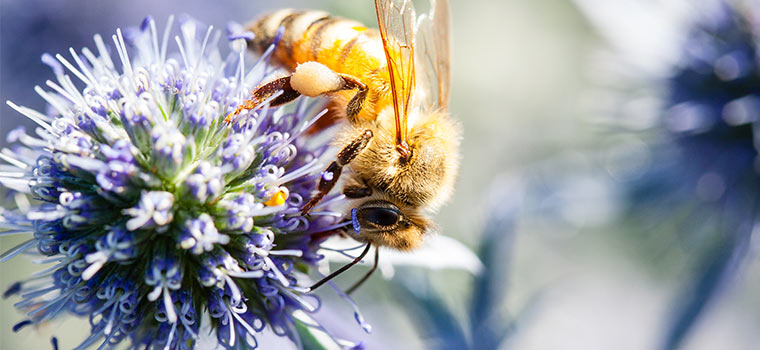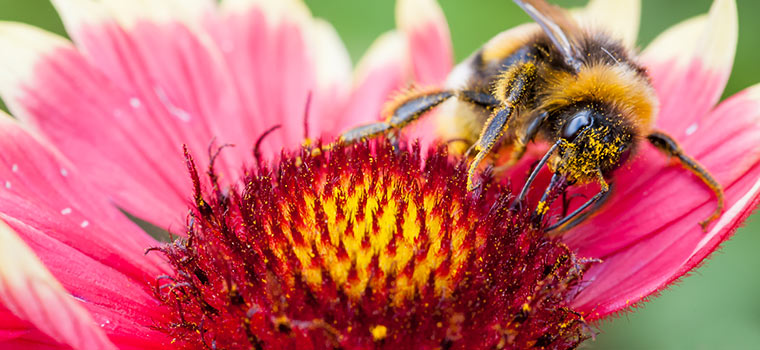Plan Bee: Attract Pollinators to Your Garden
Savvy growers understand the crucial role the bee and butterfly and other pollinators play in their gardens, nurseries, orchards, vineyards and farms.
How important are they? So essential that at least 75% of the world’s flowering plant species depend on pollinators. In addition, pollinators are responsible for an estimated one-third of the food we eat. They also support ecosystems that clean the air, purify groundwater, sustain wildlife and stabilize soils.

As a group, bees—including the humble honeybee and the velvety bumble bee—are the most important pollinators of all. (Each year, honeybees alone pollinate $15 billion worth of U.S. food crops, amounting to almost boundless bites of food.) Other well-known pollinators include not only butterflies and hummingbirds, but also moths and bats. Are wasps pollinators? Yes, as are flies, mosquitoes, beetles and other insect pests. Some flightless animal pollinators are bears, deer, rabbits, shrews and lizards, who can accidentally come in contact with flowering plants and unwittingly spread pollen.
Pollination is the transfer of pollen grains from a bloom’s male reproductive organ, the anther, to the female stigma, which is at the tip of the pistil. This process—which can take place within the same bloom, between different flowers on the same plant or between blooms on two plants—can lead to fertilization. Fertilized plants are able to bear full-bodied fruits and vegetables. They can also produce viable seeds that become their offspring. People as well as plants rely heavily on living creatures that move pollen.
The pollen-transfer process is essentially the same regardless of the creatures doing the transferring to the pollinator flower. In the case of a bee, as it collects nectar and pollen from the flower of a plant, some pollen sticks to the hairs of its body. When the bee visits the next flower and a bit of that pollen is rubbed onto the bloom’s stigma, fertilization can ensue. Without native bees to pollinate crop species, many experts say the modern agriculture industry probably would collapse.
At the end of the 20th century, beekeepers, particularly in North America and Europe, started noticing significantly fewer worker bees in their hives. This phenomenon was labeled in 2006 as Colony Collapse Disorder. The loss of bees in the wild seems to be caused by several factors ranging from pesticide use to loss of habitat to viruses to parasites to genetics that make certain species of honeybees more vulnerable to pathogens.

Since the bees started disappearing, at least eight species have been placed on the endangered species list in the United States. Most recently, in 2016, the U.S. Fish and Wildlife Service categorized the Rusty Patched Bumble Bee, or Bombus affinis, as endangered under the Endangered Species Act.
This bumble bee emerges in early spring to visit flowers, and is carrying pollen from April through September, spanning the life of its colony. Historically, the bee could be found throughout much of the East and Upper Midwest, from Maine down to northeastern Georgia and west to the eastern Dakotas. Its range before 2000 included 28 states, the District of Columbia, and the Canadian provinces of Quebec and Ontario. Since then, it has been reported in only 13 states and Ontario, according to the service.
The latest data indicates that honeybees are not only still in serious trouble in the U.S. and elsewhere in North America, but little progress is being made to stop or reduce their decline. On June 19, 2019, the University of Maryland-led nonprofit Bee Informed Partnership announced the preliminary results of its latest annual nationwide survey. Its key finding: U.S. beekeepers lost 40.7% of their honeybee colonies between April 2018 and April 2019.
While the 40.7% annual loss of these vital pollinators represents a slight increase over the annual average loss of 38.7%, the winter loss of 37.7% was the highest winter loss reported since the survey started in 2006. In addition, last winter’s loss was 8.9 percentage points higher than the survey’s average winter loss.
“Just looking at the overall picture and the 10-year trends, it’s disconcerting that we’re still seeing elevated losses after over a decade of survey and quite intense work to try to understand and reduce colony loss,” said Geoffrey Williams, assistant professor of entomology at Auburn University and the survey’s co-author. “We don’t seem to be making particularly great progress to reduce overall losses.”
The primary concern among beekeepers, and a major contributor to winter colony losses, is varroa mites. These easily spreading, lethal parasites have been introducing viruses into bee colonies for years.
“But mites are not the only problem,” said Dennis vanEngelsdorp, associate professor of entomology at the University of Maryland and president of the Bee Informed Partnership. “Land-use changes have led to a lack of nutrition-rich pollen sources for bees, causing poor nutrition. Pesticide exposures, environmental factors and beekeeping practices all play some role as well.”
Commercial and backyard beekeeping operations were surveyed to track the survival rates of their honeybee colonies. Nearly 4,700 beekeepers managing 319,787 colonies from all 50 states and the District of Columbia responded to the 2019 survey. They represent about 12% of the nation’s estimated 2.69 million managed colonies.
Honeybees have lived on the planet for an estimated 25 million years. Besides benefiting humans with their honey, bees also create useful wax. A bee lives an average of five years, and while some people fear them, they are not naturally aggressive and sting only when they believe their hive is threatened.
Remember that honeybees are not pests like wasps or yellow jackets. They live in highly organized societies, and each has a specific role such as forager, construction worker, nurse, guard, royal attendant, etc.
As for the decline of the Rusty Patched Bumble Bee, several factors similar to those affecting honeybees apparently are at work:
- Habitat loss and deterioration. Most prairies and grasslands of the Upper Midwest and Northeast have been converted in recent years to monoculture farms—those specializing in a single crop or livestock species—or have been developed for commercial or residential use.
- Intensive farming. Technological advances that have improved farm efficiency have unfortunately created practices harmful to bumble bees. They include the increased use of pesticides–bumble bees can ingest contaminated nectar and pollen, and absorb toxins directly through their exoskeletons–and reduced crop diversity, which resulted in less availability for the bees to the flowering crops.
- Climate change. Greater extremes of temperature and precipitation, late frosts and other changes may lead to more exposure or susceptibility to disease, fewer flowering plants, less time for foraging and other obstacles for bumble bees.
The Fish and Wildlife Service says gardeners can do a lot to help boost the population of the Rusty Patched Bumble Bee (and other bees):
- Add more pollinator-friendly plants to gardens or patio pots, including roses, hyacinth, phlox, bee balm (naturally, bee balm attracts bees!), foxglove, crocus, coneflowers and dahlias.
- Plant flowering trees or shrubs in yards.
- Limit or end your use of pesticides and chemical fertilizers.
- Use native plants, not invasive ones, whose flowers excel at attracting bees.
- Provide bumble bees with natural, brushy nesting areas that are unmowed and untilled.
- Tolerate the bumble bee nests you discover.

Concern about pollinator declines led to the formation of the North American Pollinator Protection Campaign, a collaborative effort of researchers, government officials and others aimed at pollinator conservation and education. Among its achievements since being established in 1999 is the creation of a panel that issued, in 2006, the first scientific report demonstrating major pollinator decline in North America.



